Tracing Back the History of Pepper (Capsicum annuum) in the Iberian Peninsula from a Phenomics Point of View
Abstract
1. Introduction
2. Results
2.1. Digital Analysis
2.2. From America to the Iberian Peninsula and the Mediterranean Basin
2.3. Evolution of Pungency
2.4. Multivariate Analysis
3. Discussion
4. Materials and Methods
4.1. Plant Material
4.2. Fruit Phenomics Assessment
4.3. Statistical Analyses
5. Conclusions
Supplementary Materials
Author Contributions
Funding
Data Availability Statement
Acknowledgments
Conflicts of Interest
References
- FAOSTAT. About Trade: Crops and Livestock Products. 2020. Available online: http://faostat.fao.org/site/535/default.aspx#ancor (accessed on 19 April 2022).
- Barboza, G.E.; Carrizo García, C.; Leiva González, S.; Scaldaferro, M.; Reyes, X. Four new species of Capsicum (Solanaceae) from the tropical Andes and an update on the phylogeny of the genus. PLoS ONE 2019, 14, e0209792. [Google Scholar] [CrossRef] [PubMed]
- Carrizo García, C.; Barfuss, M.H.J.; Sehr, E.M.; Barboza, G.E.; Samuel, R.; Moscone, E.A.; Ehrendorfer, F. Phylogenetic relationships, diversification and expansion of chili peppers (Capsicum, Solanaceae). Ann. Bot. 2016, 118, 35–51. [Google Scholar] [CrossRef]
- Kraft, K.H.; Brown, C.H.; Nabhan, G.P.; Luedeling, E.; Luna Ruiz, J.J.; d’Eeckenbrugge, G.C.; Hijmans, R.J.; Gepts, P. Multiple lines of evidence for the origin of domesticated chili pepper, Capsicum annuum, in Mexico. Proc. Natl. Acad. Sci. USA 2014, 111, 6165–6170. [Google Scholar] [CrossRef] [PubMed]
- Andrews, J. Peppers: The Domesticated Capsicums; University of Texas Press: Austin, TX, USA, 1984. [Google Scholar]
- Andrews, J. Diffusion of mesoamerican food complex to southeastern Europe. Geograph. Rev. 1993, 83, 194–204. [Google Scholar] [CrossRef]
- Bosland, P.W.; Votava, E.J. Peppers: Vegetable and Spice Capsicum, 2nd ed.; CABI Publishing: Wallingford, UK, 2012. [Google Scholar]
- Hancock, J.F. Plant Evolution and the Origin of Crop Species; CABI Publishing: Cambridge, UK, 2004. [Google Scholar]
- Nuez, F.; Gil, R.; Costa, J. El Cultivo de Pimientos, Chiles y Ajies; Mundi-Prensa: Madrid, Spain, 1996. [Google Scholar]
- Rivas-Martínez, S.; Penas, A.; González, T.; Cantó, P.; Río, S.; Costa, J.; Molero, J. Biogeographic units of the Iberian Peninsula and Baelaric Islands to district level. A concise synopsis. In Plant and Vegetation. The Vegetation of the Iberian Peninsula; Loidi, J., Ed.; Springer Nature: Urdorf, Switzerland, 2017; Volume 12, pp. 131–188. [Google Scholar]
- Spanish National Geographic Insitute. Available online: https://www.ign.es (accessed on 10 May 2022).
- Rivera, A.; Monteagudo, A.B.; Igartua, E.; Taboada, A.; García-Ulloa, A.; Pomar, F.; Riveiro-Leira, M.; Silvar, C. Assessing genetic and phenotypic diversity in pepper (Capsicum annuum L.) landraces from North-West Spain. Sci. Hortic. 2016, 203, 1–11. [Google Scholar] [CrossRef]
- Rodríguez, A.; Pereira, L.; Fita, A.M. Pimiento. In Las Variedades Locales en la Mejora Genética de Plantas; Ruiz de Galarreta, J.I., Prohens, J., Tierno, R., Eds.; Servicio Central de Publicaciones del Gobierno Vasco: Vitoria-Gasteiz, Spain, 2016. [Google Scholar]
- Spanish Ministry of Agriculture, Fisheries and Food. Available online: https://www.mapa.gob.es/en (accessed on 10 May 2022).
- Brugarolas, M.; Martinez-Carrasco, L.; Martinez-Poveda, A.; Ruiz, J.J. A competitive strategy for vegetable products: Traditional varieties of tomato in the local market. Span. J. Agric. Res. 2009, 7, 294–304. [Google Scholar] [CrossRef]
- Voss-Fels, K.P.; Stahl, A.; Hickey, L.T. QyA: Modern crop breeding for future food security. BMC Biol. 2019, 17, 18. [Google Scholar] [CrossRef] [PubMed]
- Naegele, R.P.; Mitchell, J.; Hausbeck, M.K. Genetic diversity, population structure, and heritability of fruit traits in Capsicum annuum. PLoS ONE 2016, 11, e0156969. [Google Scholar] [CrossRef]
- Paran, I.; Fallik, E. Breeding for fruit quality in pepper (Capsicum spp.). In Breeding for Fruit Quality; Jenks, M.A., Bebeli, B.J., Eds.; Wiley: Hoboken, NJ, USA, 2011. [Google Scholar]
- IPGRI; AVRDC; CATIE. Descriptors for Capsicum (Capsicum spp.); International Plant Genetic Resources Institute: Rome, Italy, 1995. [Google Scholar]
- Figàs, M.R.; Prohens, J.; Casanova, C.; Fernández-de-Córdova, P.; Soler, S. Variation of morphological descriptors for the evaluation of tomato germplasm and their stability across different growing conditions. Sci. Hortic. 2018, 238, 107–115. [Google Scholar] [CrossRef]
- Brewer, M.T.; Lang, L.; Fujimura, K.; Dujmovic, N.; Gray, S.; van der Knaap, E. Development of a Controlled Vocabulary and Software Application to Analyze Fruit Shape Variation in Tomato and Other Plant Species. Plant. Physiol. 2006, 141, 15–25. [Google Scholar] [CrossRef]
- Rodríguez, G.R.; Moyseenko, J.B.; Robbins, M.D.; Morejón, N.H.; Francis, D.M.; van der Knaap, E. Tomato Analyzer: A Useful Software Application to Collect Accurate and Detailed Morphological and Colorimetric Data from Two-dimensional Objects. JoVE J. Vis. Exp. 2010, 37, e1856. [Google Scholar] [CrossRef] [PubMed]
- González-Pérez, S.; Garcés-Claver, A.; Mallor, C.; Sáenz de Miera, L.E.; Fayos, O.; Pomar, F.; Merino, F.; Silvar, C. New insights into Capsicum spp. relatedness and the diversification process of Capsicum annuum in Spain. PLoS ONE 2014, 9, e116276. [Google Scholar] [CrossRef] [PubMed]
- Pereira-Dias, L.; Vilanova, S.; Fita, A.; Prohens, J.; Rodríguez-Burruezo, A. Genetic diversity, population structure, and relationships in a collection of pepper (Capsicum spp.) landraces from the Spanish centre of diversity revealed by genotyping-by-sequencing (GBS). Hortic. Res. 2019, 6, 54. [Google Scholar] [CrossRef] [PubMed]
- Rodríguez-Burruezo, A.; Raigón, M.D.; Prohens, J.; Nuez, F. Characterization for bioactive compounds of Spanish pepper landraces. 28th International Horticultural Congress (ISHS). Acta Hortic. 2010, 918, 537–543. [Google Scholar]
- Ribes-Moya, A.M.; Adalid, A.M.; Raigón, M.D.; Hellín, P.; Fita, A.; Rodríguez-Burruezo, A. Variation in flavonoids in a collection of peppers (Capsicum spp.) under organic and conventional cultivation: Effect of the genotype, ripening stage, and growing system. J. Sci. Food Agric. 2020, 100, 2208–2223. [Google Scholar] [CrossRef] [PubMed]
- Pereira-Dias, L.; Fita, A.; Vilanova, S.; Sánchez-López, E.; Rodríguez-Burruezo, A. Phenomics of elite heirlooms of peppers (Capsicum annuum L.) from the Spanish centre of diversity: Conventional and high-throughput digital tools towards varietal typification. Sci. Hortic. 2020, 265, 109245. [Google Scholar] [CrossRef]
- Esposito, S.; Carputo, D.; Cardi, T.; Tripodi, P. Applications and trends of machine learning in genomics and phenomics for next-generation breeding. Plants 2019, 9, 34. [Google Scholar] [CrossRef]
- Narez-Jiménez, C.; de la Cruz Lázaro, E.; Gómez-Vázquez, A.; Castañón-Nájeram, G.; Cruz-Hernández, A.; Márquez-Quiroz, C. In Situ morphological diversity of wild peppers (Capsicum spp.) in tabasco, México. Rev. Fitotec. Mex. 2014, 37, 209–215. [Google Scholar]
- van Zonneveld, M.; Ramirez, M.; Williams, D.E.; Petz, M.; Meckelmann, S.; Avila, T.; Bejarano, C.; Ríos, L.; Peña, K.; Jäger, M.; et al. Screening genetic resources of Capsicum peppers in their primary center of diversity in Bolivia and Peru. PLoS ONE 2015, 10, e0134663. [Google Scholar] [CrossRef]
- Hayano-Kanashiro, C.; Gámez-Meza, N.; Medina-Juárez, L.A. Wild Pepper Capsicum annuum L. var. glabriusculum: Taxonomy, plant morphology, distribution, genetic diversity, genome sequencing, and phytochemical compounds. Crop Sci. 2016, 56, 1–11. [Google Scholar] [CrossRef]
- Santiago-Luna, E.G.; Carrillo-Rodríguez, J.C.; Chávez-Servia, J.L.; Perales-Segovia, C.; Heredia-Garcia, E. Variation of plant and fruit traits in native Mexican costeño pepper. Hortic. Bras. 2018, 36, 399–407. [Google Scholar] [CrossRef]
- García-González, C.A.; Silvar, C. Phytochemical Assessment of Native Ecuadorian Peppers (Capsicum spp.) and Correlation Analysis to Fruit Phenomics. Plants 2020, 9, 986. [Google Scholar] [CrossRef] [PubMed]
- González-López, J.; Rodríguez-Moar, S.; Silvar, C. Correlation Analysis of High-Throughput Fruit Phenomics and Biochemical Profiles in Native Peppers (Capsicum spp.) from the Primary Center of Diversification. Agronomy 2021, 11, 262. [Google Scholar] [CrossRef]
- Tripodi, P.; Greco, B. Large scale phenotyping provides insight into the diversity of vegetative and reproductive organs in a wide collection of wild and domesticated peppers (Capsicum spp.). Plants 2018, 7, 103. [Google Scholar] [CrossRef] [PubMed]
- Figàs, M.R.; Prohens, J.; Raigón, M.D.; Fernández-de-Córdova, P.; Fita, A.; Soler, S. Characterization of a collection of local varieties of tomato (Solanum lycopersicum L.) using conventional descriptors and the high-throughput phenomics tool Tomato Analyzer. Genet. Resour. Crop Evol. 2015, 62, 189–204. [Google Scholar] [CrossRef]
- Nankar, A.N.; Tringovska, I.; Grozeva, S.; Ganeva, D.; Kostova, D. Tomato phenotypic diversity determined by combined approaches of conventional and high-throughput tomato analyzer phenotyping. Plants 2020, 9, 197. [Google Scholar] [CrossRef]
- Hurtado, M.; Vilanova, S.; Plazas, M.; Gramazio, P.; Herraiz, F.J.; Andújar, I.; Prohens, J. Phenomics of fruit shape in eggplant (Solanum melongena L.) using Tomato Analyzer software. Sci. Hortic. 2013, 164, 625–632. [Google Scholar] [CrossRef]
- Nankar, A.N.; Tringovska, I.; Grozeva, S.; Todorova, V.; Kostova, D. Application of high-throughput phenotyping tool Tomato Analyzer to characterize Balkan Capsicum fruit diversity. Sci. Hortic. 2020, 260, 108862. [Google Scholar] [CrossRef]
- Costa, C.; Antonucci, F.; Pallottino, F.; Aguzzi, J.; Sun, D.W.; Menesatti, P. Shape analysis of agricultural products: A review of recent research advances and potential application to computer vision. Food Bioprocess Technol. 2011, 4, 673–692. [Google Scholar] [CrossRef]
- Zhigila, D.A.; Abdul Rahaman, A.A.; Kolawole, O.S.; Oladele, F.A. Fruit morphology as taxonomic features in five varieties of Capsicum annuum L. Solanaceae. J. Bot. 2014, 2014, 540868. [Google Scholar] [CrossRef]
- Vilarinho, L.B.O.; da Silva, D.J.H.; Greene, A.; Salazar, K.D.; Alves, C.; Eveleth, M.; Nichols, B.; Tehseen, S.; Khoury, J.K., Jr.; Johnson, J.V.; et al. Inheritance of fruit traits in Capsicum annuum: Heirloom cultivars as sources of quality parameters relating to pericarp shape, color, thickness, and total soluble solids. J. Am. Soc. Hortic. Sci. 2015, 140, 597–604. [Google Scholar] [CrossRef]
- Barchi, L.; Lefèbvre, V.; Sage-Palloix, A.; Lanteri, S.; Palloix, A. QTL analysis of plant development and fruit traits in pepper and performance of selective phenotyping. Theor. Appl. Genet. 2009, 118, 1157–1171. [Google Scholar] [CrossRef] [PubMed]
- Hill, T.A.; Chunthawodtiporn, J.; Ashrafi, H.; Stoffel, K.; Weir, A.; Van Deynze, A. Regions underlying population structure and the genomics of organ size determination in Capsicum annuum. Plant Genome 2017, 10, 1–14. [Google Scholar] [CrossRef] [PubMed]
- Chunthawodtiporn, J.; Hill, T.; Stoffel, K.; Van Deynze, A. Quantitative Trait Loci controlling fruit size and other horticultural traits in Bell Pepper (Capsicum annuum). Plant Genome 2018, 11, 160125. [Google Scholar] [CrossRef] [PubMed]
- Tripodi, P.; Rabanus-Wallace, M.T.; Barchi, L.; Kale, S.; Esposito, S.; Acquadro, A.; Schafleitner, R.; van Zonneveld, M.; Prohens, J.; Diez, M.J.; et al. Global range expansion history of pepper (Capsicum spp.) revealed by over 10,000 genebank accessions. Proc. Natl. Acad. Sci. USA 2021, 118, e2104315118. [Google Scholar] [CrossRef]
- Alercia, A.; Diulgheroff, S.; Mackay, M. Descriptores de Pasaporte para Cultivos Múltiples FAO/BIOVERSITY V.2.1; Organización de las Naciones Unidas para la Alimentación y la Agricultura; Bioversity International Publication: Rome, Italy, 2015. [Google Scholar]
- UPOV Test Guidelin. Available online: https://www.upov.int/en/publications/tg-rom/tg076/tg_76_8.pdf (accessed on 15 June 2022).
- Xiao, Q.; Bai, X.; Zhang, C.; He, Y. Advanced high-throughput plant phenotyping techniques for genome-wide association studies: A review. J. Adv. Res. 2021, 35, 215–230. [Google Scholar] [CrossRef]
- Djian-Caporalino, C.; Lefebvre, V.; Sage-Daubeze, A.M.; Palloix, A. Capsicum. In Vegetable Crops: Genetic Resources, Chromosome Engineering and Crop Improvement Series; Singh, R.J., Ed.; CRC Press: Boca Raton, FL, USA, 2007. [Google Scholar]
- Silvar, C.; García-González, C.A. Deciphering Genetic Diversity in the Origins of Pepper (Capsicum spp.) and Comparison with Worldwide Variability. Crop Sci. 2016, 56, 3100–3111. [Google Scholar] [CrossRef]
- Albrecht, E.; Zhang, D.; Mays, A.D.; Saftner, R.A.; Stommel, J.R. Genetic diversity in Capsicum baccatum is significantly influenced by its ecogeographical distribution. BMC Genet. 2012, 13, 68. [Google Scholar] [CrossRef]
- Moses, M.; Umaharan, P.; Dayanandan, S. Microsatellite based analysis of the genetic structure and diversity of Capsicum chinense in the Neotropics. Genet. Resour. Crop Evol. 2014, 61, 741–755. [Google Scholar] [CrossRef]
- Kim, S.; Park, M.; Yeon, S.I.; Kim, Y.M.; Lee, J.M.; Lee, H.; Seo, E.; Choi, J.; Cheong, K.; Kim, K.; et al. Genome sequence of the hot pepper provides insights into the evolution of pungency in Capsicum species. Nat. Genet. 2014, 46, 270–279. [Google Scholar] [CrossRef]
- Scossa, F.; Roda, F.; Tohge, T.; Georgiev, M.I.; Fernie, A.R. The Hot and the Colorful: Understanding the Metabolism, Genetics and Evolution of Consumer Preferred Metabolic Traits in Pepper and Related Species. Crit. Rev. Plant Sci. 2019, 38, 339–381. [Google Scholar] [CrossRef]
- Paran, I.; van der Knaap, E. Genetic and molecular regulation of fruit and plant domestication traits in tomato and pepper. J. Exp. Bot. 2007, 58, 3841–3852. [Google Scholar] [CrossRef] [PubMed]
- Qin, C.; Changshui, Y.; Shen, Y.; Fang, X.; Chen, L.; Min, J.; Cheng, J.; Zhao, S.; Xu, M.; Luo, Y.; et al. Whole genome sequencing of cultivated and wild peppers provides insights into Capsicum domestication and specialization. Proc. Natl. Acad. Sci. USA 2014, 111, 5135–5140. [Google Scholar] [CrossRef] [PubMed]
- Silvar, C.; García-González, C.A. Screening old peppers (Capsicum spp.) for disease resistance and pungency-related traits. Sci. Hortic. 2017, 218, 249–257. [Google Scholar] [CrossRef]
- Darrigues, A.; Hall, J.; van der Knaap, E.; Francis, D.M.; Dujmovic, N.; Gray, S. Tomato analyzer-color test: A new tool for efficient digital phenotyping. J. Am. Soc. Hort. Sci. 2008, 133, 579–586. [Google Scholar] [CrossRef]
- SPSS. SPSS Statistics for Windows, version 17.0; SPSS Inc.: Chicago, IL, USA, 2008.
- R Core Team. R: A Language and Environment for Statistical Computing; R Foundation for Statistical Computing: Vienna, Austria, 2019. [Google Scholar]
- Wickham, H. Ggplot2: Elegant Graphics for Data Analysis; Springer: New York, NY, USA, 2016. [Google Scholar]
- Abdi, H. The Bonferonni and Šidák Corrections for Multiple Comparisons. In Encyclopedia of Measurement and Statistics; Salkind, N.J., Ed.; Sage: Thousand Oaks, CA, USA, 2007. [Google Scholar]
- Revelle, W. Psych: Procedures for Psychological, Psychometric, and Personality Research; Northwestern University: Evanston, IL, USA, 2022. [Google Scholar]
- Wei, T.; Simko, V. R Package “Corrplot”: Visualization of a Correlation Matrix. 2017. Available online: https://github.com/taiyun/corrplot (accessed on 9 May 2022).
- Epskamp, S.; Cramer, A.O.J.; Waldorp, L.J.; Schmittmann, V.D.; Borsboom, D. Qgraph: Network Visualizations of Relationships in Psychometric Data. J. Stat. Soft. 2012, 48, 1–18. [Google Scholar] [CrossRef]
- Kassambara, A.; Mundt, F. Factoextra: Extract and Visualize the Results of Multivariate Data Analyses, 2020. Available online: https://CRAN.R-project.org/package=factoextra (accessed on 9 May 2022).
- Kumar, S.; Stecher, G.; Li, M.; Knyaz, C.; Tamura, K. MEGA X: Molecular Evolutionary Genetics Analysis across Computing Platforms. Mol. Biol. Evol. 2018, 35, 1547–1549. [Google Scholar] [CrossRef]
- Warnes, G.R.; Bolker, B.M.; Bonebakker, L.; Gentleman, R.; Liaw, W.; Lumley, T.; Maechler, M.; Magnusson, A.; Moeller, S.; Schwartz, M.L.; et al. Gplots: Various R Programming Tools for Plotting Data; 2015; Available online: https://www.scienceopen.com/document?vid=0e5d8e31-1fe4-492f-a3d8-8cd71b2b8ad9 (accessed on 9 May 2022).
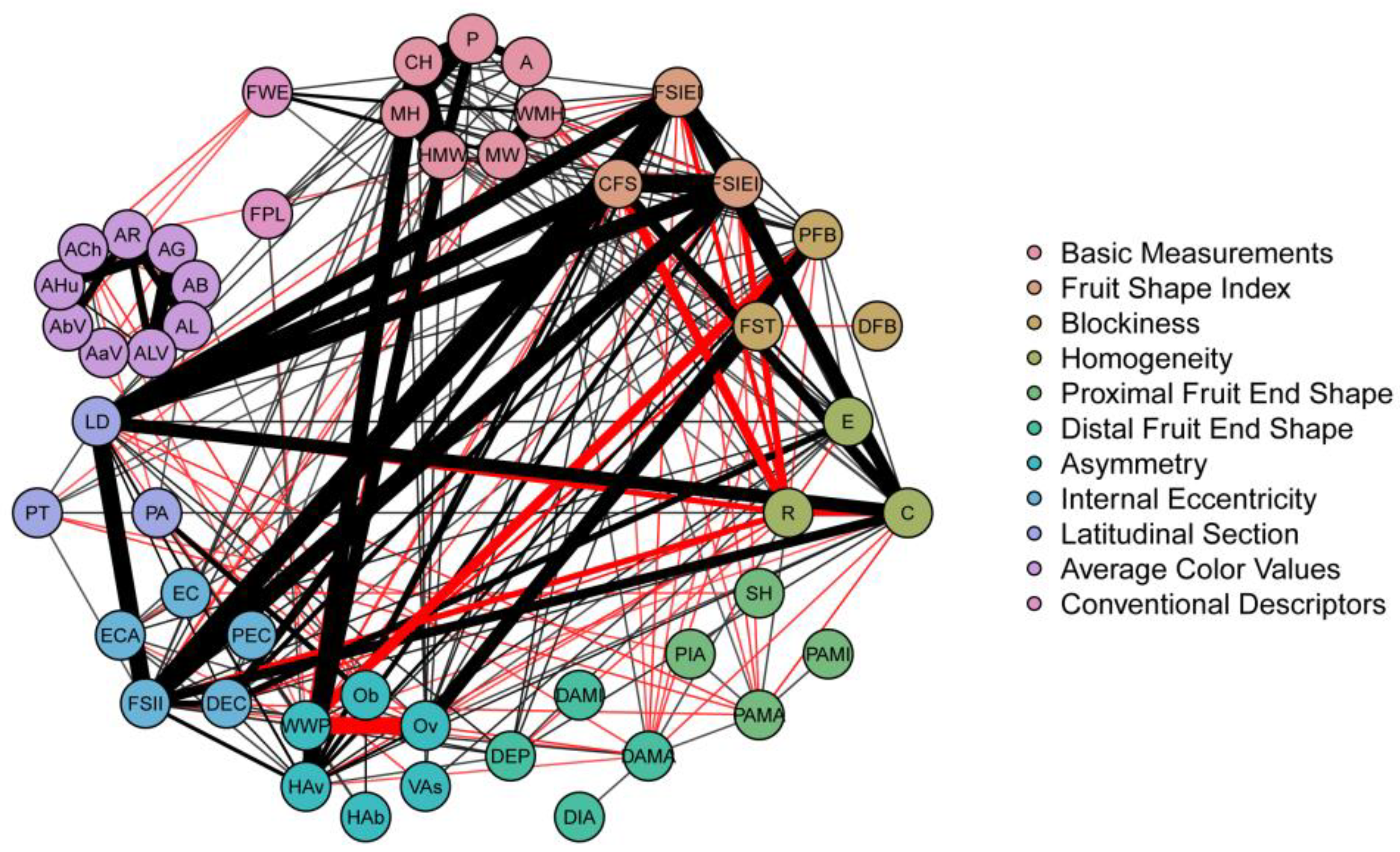
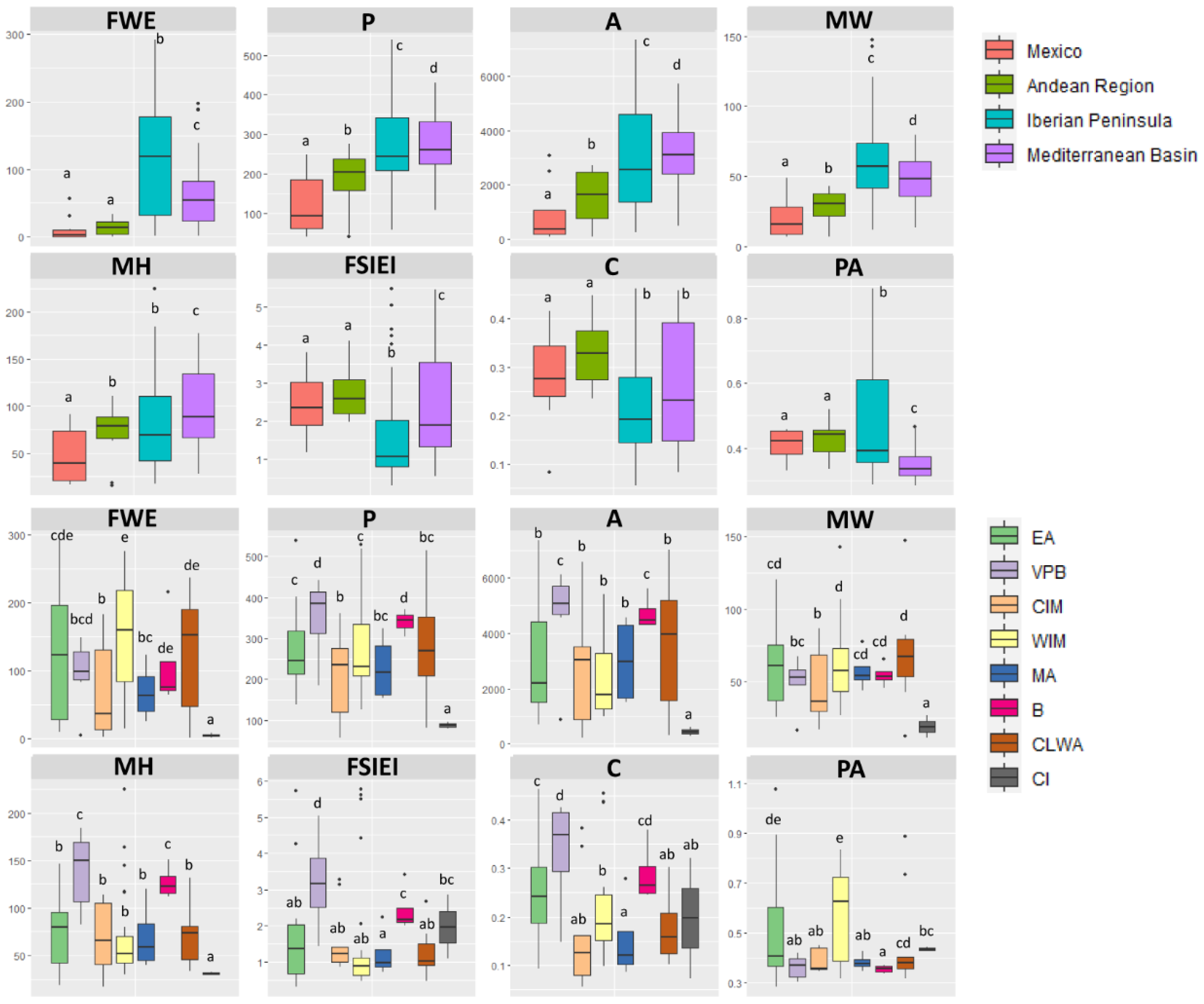
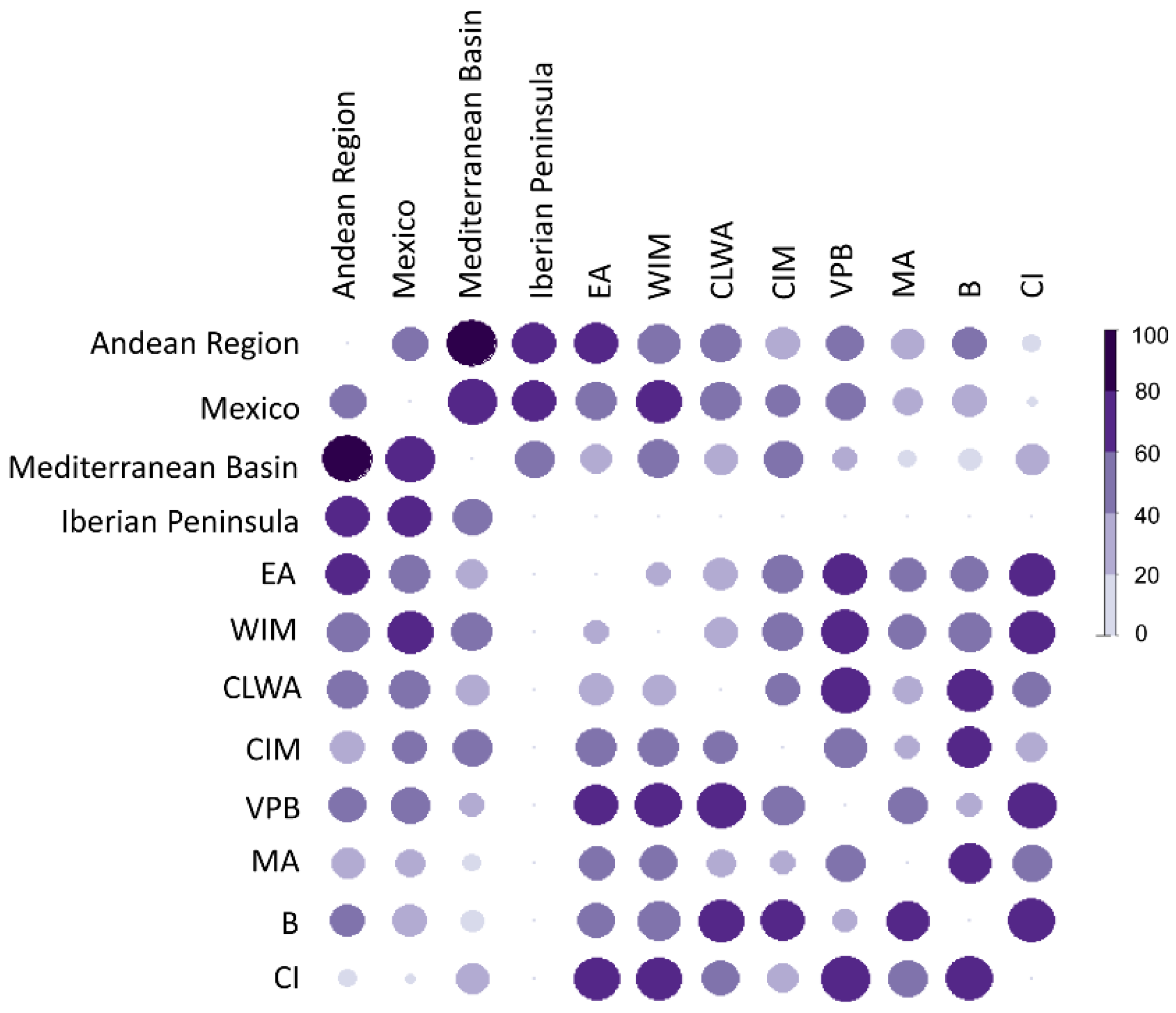
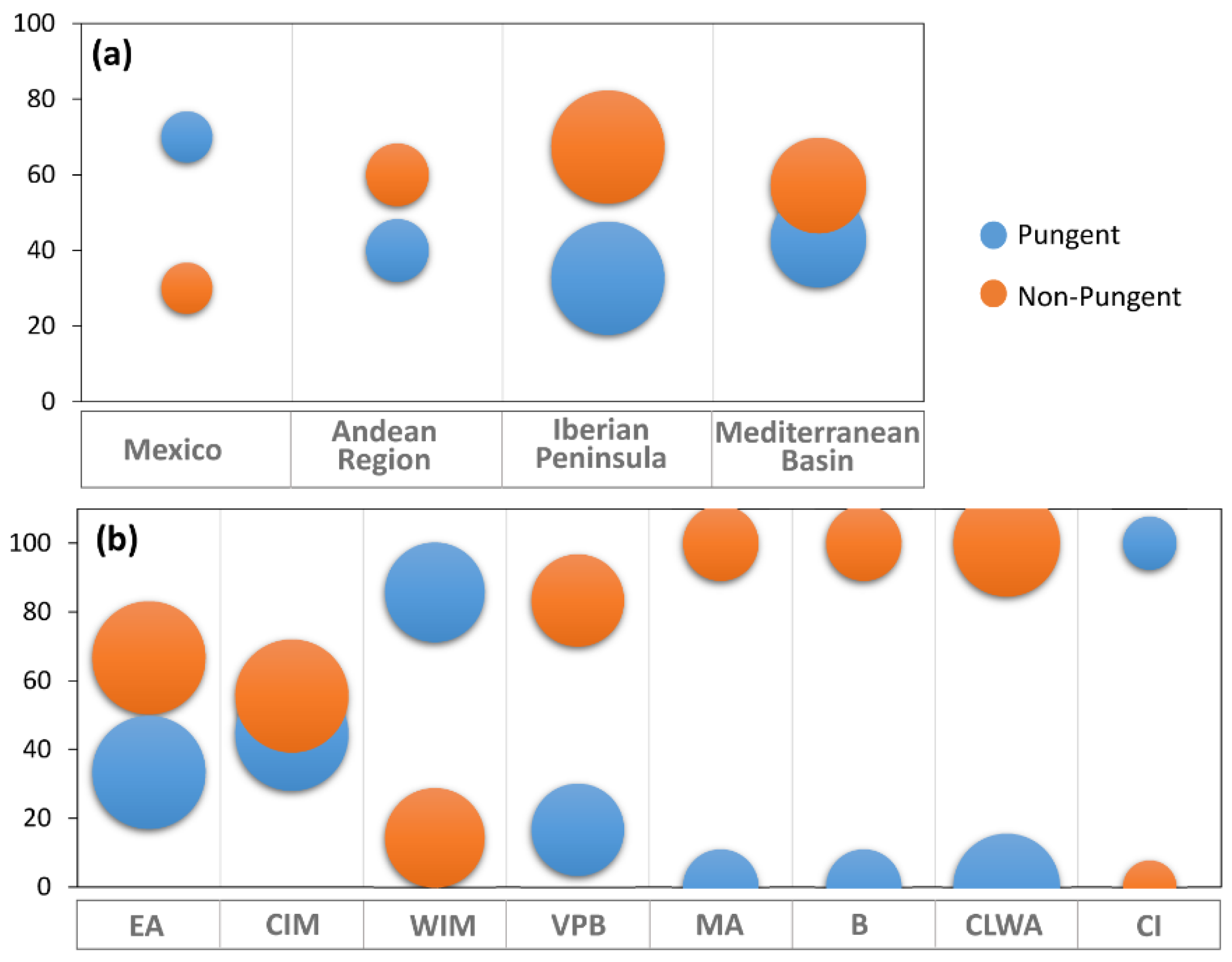

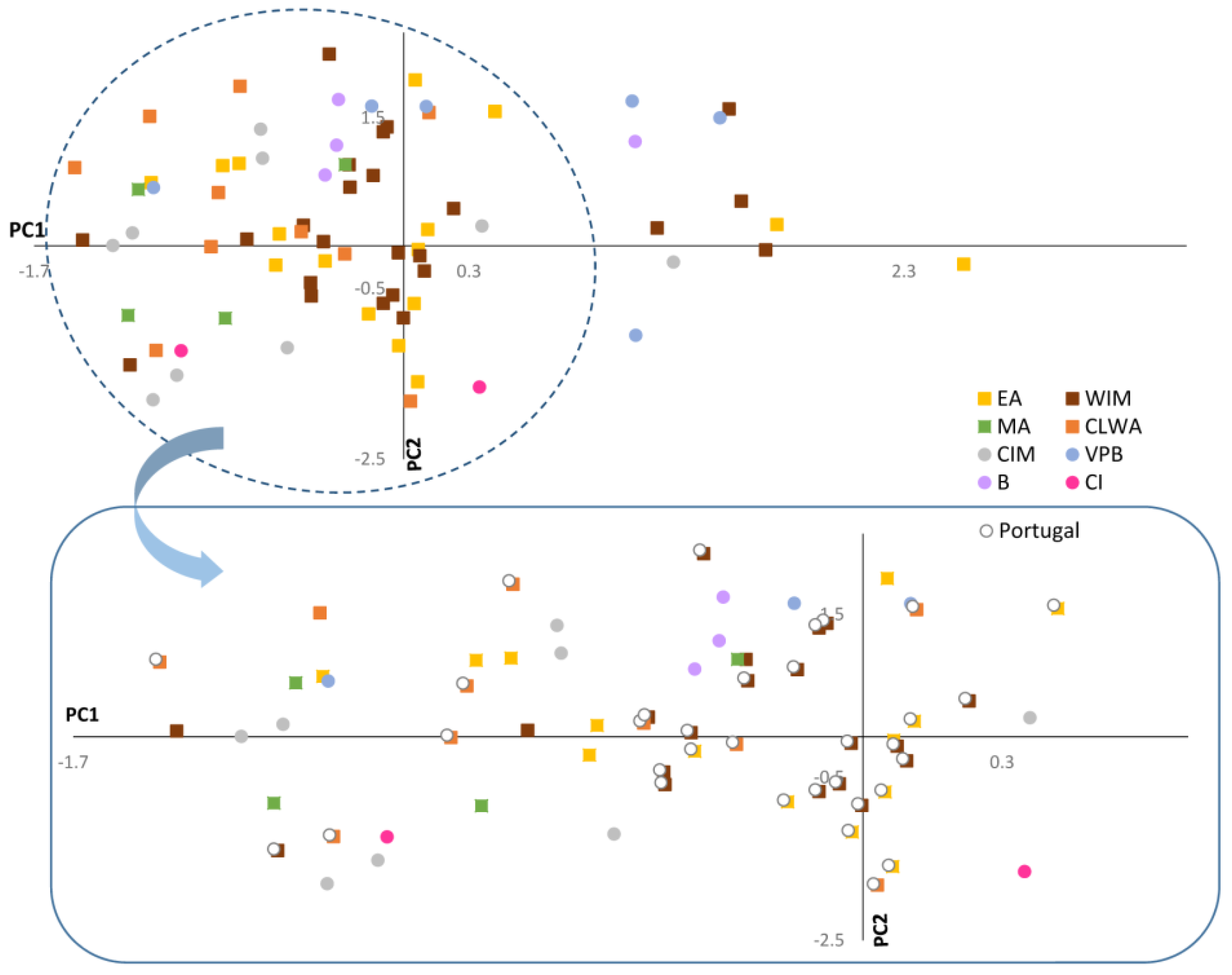

| Trait | Sum of Squares | Mean Squares | F-Value † | R-Square | Mean | Range | %CV |
|---|---|---|---|---|---|---|---|
| FWE | 536.75 | 4.87 | 82.62 * | 0.93 | 59.12 | 0.10–404.30 | 117.3 |
| FPL | 536.64 | 4.87 | 23.70 * | 0.80 | 3.99 | 0.90–9.40 | 31.5 |
| P | 454.07 | 4.14 | 80.18 * | 0.93 | 233.10 | 28.02–662.51 | 47.7 |
| A | 670.19 | 6.15 | 56.37 * | 0.90 | 2267.03 | 51.95–9451.79 | 72.4 |
| WMH | 454.19 | 4.14 | 70.69 * | 0.92 | 38.05 | 3.89–164.59 | 63.3 |
| MW | 466.73 | 4.25 | 75.42 * | 0.93 | 44.83 | 5.33–175.09 | 54.9 |
| HMW | 380.06 | 3.46 | 61.81 * | 0.91 | 68.46 | 5.16–258.91 | 59.9 |
| MH | 393.84 | 3.58 | 87.42 * | 0.94 | 77.30 | 9.90–260.18 | 58.8 |
| CH | 413.08 | 3.75 | 77.62 * | 0.93 | 82.07 | 11.59–266.25 | 54.5 |
| FSIEI | 237.79 | 2.16 | 57.30 * | 0.91 | 2.17 | 0.23–8.60 | 68.5 |
| FSIEII | 204.09 | 1.85 | 52.31 * | 0.90 | 2.68 | 0.20–15.75 | 88.6 |
| CFSI | 184.57 | 1.69 | 40.96 * | 0.87 | 3.17 | 0.27–20.86 | 86.3 |
| PFB | 249.49 | 2.27 | 8.22 * | 0.55 | 0.96 | 0.17–2.29 | 30.4 |
| DFB | 156.92 | 1.42 | 3.71 * | 0.32 | 0.59 | 0.08–2.00 | 31.7 |
| FST | 210.61 | 1.91 | 6.08 * | 0.46 | 1.79 | 0.27–10.94 | 45.6 |
| E | 205.09 | 1.86 | 9.26 * | 0.58 | 0.10 | 0.03–0.28 | 37.2 |
| C | 427.10 | 3.88 | 54.32 * | 0.90 | 0.26 | 0.03–0.47 | 45.6 |
| R | 224.69 | 2.04 | 5.15 * | 0.41 | 0.45 | 0.05–0.71 | 22.2 |
| SH | 148.57 | 1.35 | 2.27 * | 0.17 | 0.03 | 0.00–0.30 | 133.2 |
| PAMI | 160.14 | 1.45 | 1.88 * | 0.13 | 180.64 | 79.10–359.50 | 30.7 |
| PAMA | 389.75 | 3.54 | 7.15 * | 0.51 | 151.81 | 37.90–351.00 | 41.8 |
| DAMI | 250.44 | 2.27 | 4.16 * | 0.35 | 147.43 | 62.10–358.20 | 44.8 |
| DAMA | 321.64 | 2.92 | 7.27 * | 0.51 | 93.38 | 10.80–358.00 | 72.0 |
| Ov | 270.72 | 2.46 | 7.74 * | 0.53 | 0.33 | 0.00–0.87 | 59.2 |
| VAs | 138.18 | 1.26 | 6.64 * | 0.49 | 0.36 | 0.01–2.54 | 92.2 |
| HAov | 253.51 | 2.31 | 24.39 * | 0.80 | 0.83 | 0.00–6.28 | 106.2 |
| WWP | 210.56 | 1.91 | 6.30 * | 0.47 | 0.32 | 0.03–0.97 | 54.2 |
| EC | 249.87 | 2.27 | 6.74 * | 0.49 | 0.71 | 0.06–0.80 | 11.0 |
| FSII | 180.91 | 1.64 | 54.93 * | 0.90 | 2.65 | 0.20–14.06 | 89.0 |
| ECA | 123.01 | 1.11 | 6.36 * | 0.48 | 0.45 | 0.004–0.97 | 21.5 |
| LD | 222.93 | 2.03 | 60.51 * | 0.91 | 25.78 | 1.47–129.78 | 87.5 |
| PA | 180.49 | 1.64 | 41.59 * | 0.87 | 0.45 | 0.22–1.82 | 35.4 |
| PT | 157.06 | 1.43 | 5.18 * | 0.41 | 0.21 | 0.07–0.54 | 14.9 |
| AR | 381.90 | 3.47 | 11.33 * | 0.64 | 167.24 | 105.87–222.65 | 12.6 |
| AG | 446.34 | 4.05 | 12.76 * | 0.67 | 86.52 | 38.47–201.75 | 25.4 |
| AB | 384.49 | 3.49 | 10.54 * | 0.62 | 46.14 | 16.88–123.25 | 32.3 |
| AL | 391.03 | 3.55 | 9.24 * | 0.58 | 100.40 | 64.04–159.36 | 13.3 |
| ALV | 424.19 | 3.86 | 12.03 * | 0.65 | 46.40 | 27.88–81.03 | 15.9 |
| AaV | 449.33 | 4.08 | 16.19 * | 0.72 | 26.44 | 0.33–41.55 | 27.7 |
| AbV | 422.19 | 3.83 | 19.30 * | 0.76 | 39.65 | 18.94–68.48 | 18.9 |
| AHue | 478.73 | 4.35 | 21.05 * | 0.77 | 56.68 | 44.44–101.97 | 14.8 |
| ACh | 362.11 | 3.30 | 16.38 * | 0.73 | 48.03 | 23.87–69.14 | 17.8 |
Publisher’s Note: MDPI stays neutral with regard to jurisdictional claims in published maps and institutional affiliations. |
© 2022 by the authors. Licensee MDPI, Basel, Switzerland. This article is an open access article distributed under the terms and conditions of the Creative Commons Attribution (CC BY) license (https://creativecommons.org/licenses/by/4.0/).
Share and Cite
Silvar, C.; Rocha, F.; Barata, A.M. Tracing Back the History of Pepper (Capsicum annuum) in the Iberian Peninsula from a Phenomics Point of View. Plants 2022, 11, 3075. https://doi.org/10.3390/plants11223075
Silvar C, Rocha F, Barata AM. Tracing Back the History of Pepper (Capsicum annuum) in the Iberian Peninsula from a Phenomics Point of View. Plants. 2022; 11(22):3075. https://doi.org/10.3390/plants11223075
Chicago/Turabian StyleSilvar, Cristina, Filomena Rocha, and Ana M. Barata. 2022. "Tracing Back the History of Pepper (Capsicum annuum) in the Iberian Peninsula from a Phenomics Point of View" Plants 11, no. 22: 3075. https://doi.org/10.3390/plants11223075
APA StyleSilvar, C., Rocha, F., & Barata, A. M. (2022). Tracing Back the History of Pepper (Capsicum annuum) in the Iberian Peninsula from a Phenomics Point of View. Plants, 11(22), 3075. https://doi.org/10.3390/plants11223075







